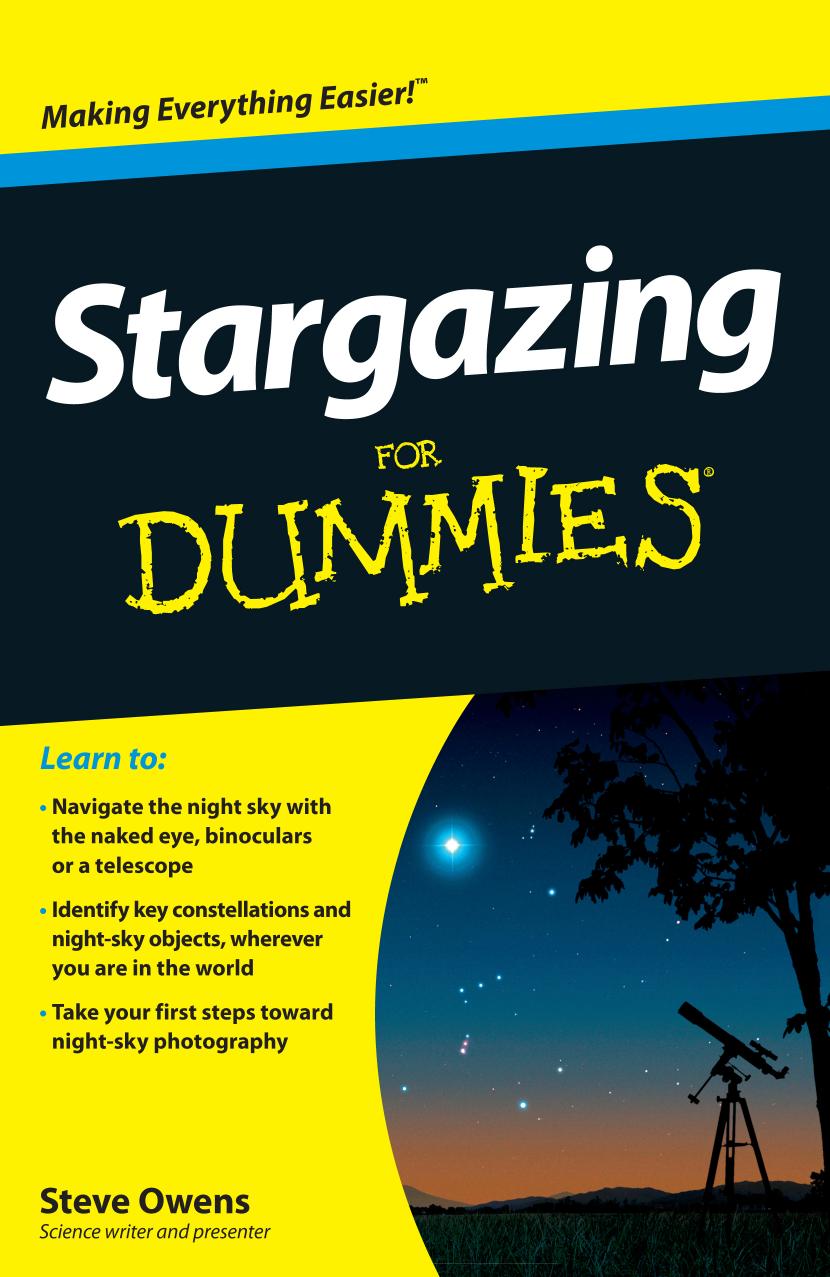Stargazing For Dummies by Steve Owens

Author:Steve Owens
Language: eng
Format: epub, mobi, azw3, pdf
Publisher: Wiley
Published: 2013-01-17T16:00:00+00:00
* * *
Holes in the ground
If a bit of space rock makes it to the ground, it can form a crater, but these craters are very rare on Earth. Earth’s atmosphere causes most space rocks to burn up before they hit the ground, and any craters that are formed are eroded away by water and weather. The Moon is covered in craters because it doesn’t have a protective atmosphere.
* * *
Viewing Manmade Lights
Believe it or not, you can also see manmade lights up in space, too. Don’t worry; the astronauts haven’t left the lights on. What you’re seeing is sunlight reflecting off the bodies or solar panels of satellites and space craft.
Currently, hundreds of working satellites are in orbit around the Earth, along with thousands of defunct satellites, bits of old rocket and space junk.
On a clear dark night, you can see a few of these satellites pass overhead. They move rather sedately against the background stars, passing across the sky in a few minutes, and most of them are really faint, at the limits of your vision. Sometimes, though, they can get really bright.
You can find out which satellites are passing over your head on websites such as www.heavens-above.com.
The International Space Station
The International Space Station (ISS) is the biggest manmade object ever to orbit the Earth, weighing in at 450 tons. The ISS is home to six astronauts at any one time. Due to its size (it wouldn’t fit on top of a football pitch), the ISS has a huge area that can catch the sunlight and reflect it back down to Earth, making it one of the brightest manmade objects visible from Earth.
As the ISS passes, you see it appear as a bright star moving slowly across the sky. The ISS is visible for only a few minutes each time, and at its brightest, it can glow brighter than the planet Venus. The ISS isn’t visible every night, but some nights you can see it several times, because it orbits the Earth once every 90 minutes. You can see the ISS only at twilight, before dawn or after dusk.
Iridium flares
The ISS (see preceding section) isn’t the brightest manmade object up there, though. The very brightest ones visible are called iridium satellites, and they appear bright for such a short time that when astronomers see them from Earth, they call them iridium flares.
Iridium flares can be much brighter than Venus, the brightest planet. They’re so bright that you can actually see them in the daytime, if you know where to look.
Download
Stargazing For Dummies by Steve Owens.mobi
Stargazing For Dummies by Steve Owens.azw3
Stargazing For Dummies by Steve Owens.pdf
This site does not store any files on its server. We only index and link to content provided by other sites. Please contact the content providers to delete copyright contents if any and email us, we'll remove relevant links or contents immediately.
| Aeronautics & Astronautics | Astronomy |
| Astrophysics & Space Science | Comets, Meteors & Asteroids |
| Cosmology | Mars |
| Solar System | Star-Gazing |
| Telescopes | UFOs |
Tools of Titans by Timothy Ferriss(8212)
Turbulence by E. J. Noyes(7935)
Secrets of Antigravity Propulsion: Tesla, UFOs, and Classified Aerospace Technology by Ph.D. Paul A. Laviolette(5309)
Astrophysics for People in a Hurry by Neil DeGrasse Tyson(5130)
Room 212 by Kate Stewart(5035)
Design of Trajectory Optimization Approach for Space Maneuver Vehicle Skip Entry Problems by Runqi Chai & Al Savvaris & Antonios Tsourdos & Senchun Chai(5011)
Pale Blue Dot by Carl Sagan(4907)
The David Icke Guide to the Global Conspiracy (and how to end it) by David Icke(4624)
A Journey Through Divination and Astronomy by Publishing Pottermore(4340)
Goodbye Paradise(3724)
Apollo 8 by Jeffrey Kluger(3635)
COSMOS by Carl Sagan(3553)
Losing the Nobel Prize by Brian Keating(3498)
The Five People You Meet in Heaven by Mitch Albom(3474)
How to Read Water: Clues and Patterns from Puddles to the Sea (Natural Navigation) by Tristan Gooley(3406)
Brief Answers to the Big Questions by Stephen Hawking(3369)
How to Read Nature by Tristan Gooley(3249)
The Order of Time by Carlo Rovelli(3144)
A Brief History of Time by Stephen Hawking(2959)
